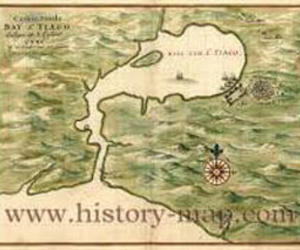The ”Texas” at Grant’s Tomb 1898 In Harlem
- Submitted by: manso
- Society
- 10 / 12 / 2010

New York City welcome to Sampson’s Fleet after the Battle of Santiago Bay, Cuba. The Battle of Santiago de Cuba, fought between Spain and the United States on July 3, 1898, was the largest naval engagement of the Spanish-American War and resulted in the destruction of the Spanish Caribbean Squadron (also known as the Flota de Ultramar).
The Texas (authorized by the U.S. Congress on 3 August 1886) had several unlucky incidents including but not limited to flooding of her gun deck and settling to the bottom at dock in New York and also receiving significant damage to her hull in dry-docking. During the period between her commissioning and the Spanish American War in 1898 she obtained a reputation as being a jinxed or unlucky ship and earned the nickname ”Old Hoodoo.”
- excerpt from wikipedia
U.S.S. TEXAS (1895-1911) later renamed San Marcos
The first Texas was laid down on 1 June 1889 at Portsmouth, Va., by the Norfolk Navy Yard; launched on 28 June 1892; sponsored by Miss Madge Houston Williams; and commissioned on 15 August 1895, Capt. Henry Glass in command.
Assigned to the North Atlantic Squadron, the warship cruised the eastern seaboard of the United States. In February 1897, she left the Atlantic for a brief cruise to the Gulf coast ports of Galveston and New Orleans. She resumed Atlantic coast duty in March of 1897 and remained so employed until the beginning of 1898. At that time, she visited Key West and the Dry Tortugas en route to Galveston for a return visit which she made in mid-February. Returning to the Atlantic via the Dry Tortugas in March, the warship arrived in Hampton Roads on the 24th and resumed normal duty with the North Atlantic Squadron.
Early in the spring, war between the United States and Spain erupted over conditions in Cuba and the supposed Spanish destruction of the battleship Maine in Havana harbor in February 1898. By 18 May, Texas was at Key West, Fla., readying to prosecute that war.
On the 21st, she arrived off Cienfuegos, Cuba, with the Flying Squadron to blockade the Cuban coast. After a return to Key West for coal, Texas arrived off Santiago de Cuba on the 27th. She patrolled off that port until 11 June on which day she made a reconnaissance mission to Guantanamo Bay. For the next five weeks, she patrolled between Santiago de Cuba and Guantanamo Bay. On 16 June, the warship joined Marblehead for a bombardment of the fort on Cayo del Tore in Guantanamo Bay. The two ships opened fire just after 1400 and ceased fire about an hour and 15 minutes later, having reduced the fort to impotency.
On 3 July, she was steaming off Santiago de Cuba when the Spanish Fleet under Admiral Cervera made a desperation attempt to escape past the American Fleet. Texas immediately took four of the enemy ships under fire. While the battleship’s main battery pounded Vizcaya and Colon, her secondary battery joined Iowa and Gloucester in battering two torpedo-boat destroyers. The two Spanish destroyers fell out of the action quickly and beached themselves, heavily damaged. One by one, the larger enemy warships also succumbed to the combined fire of the American Fleet. Each, in turn, sheered off toward shore and beached herself. Thus, Texas and the other ships of the Flying Squadron annihilated the Spanish Fleet.
Source: Naval History and Heritage Command
http://www.history.navy.mil/index.html
GENERAL GRANT NATIONAL MONUMENT (Grant’s Tomb)
Monument near the intersection of Riverside Drive and West 122nd Street in Manhattan, the final resting place of Ulysses S. Grant (1822-1885) and his wife, Julia Dent Grant (1826-1902).
The monument is a neoclassical granite structure 150 feet (forty-five meters) tall. Among its elaborate features are Doric columns, a domed rotunda, and allegorical relief sculptures symbolizing aspects of Grants life. On the exterior of the structure two figures representing victory and peace support Grants epitaph, ”Let Us Have Peace.”
The interior of the tomb is made of Lee and Carrara marble from Italy; within its center crypt are twin sarcophagi containing the remains of Grant and his wife. Grant is the only president buried in New York City, and his tomb is the second-largest mausoleum in the western hemisphere.
- (excerpts) Frank Scaturro / Encyclopedia of New York City Edited by Kenneth T. Jackson
Here is a view of either the U.S.S. ‘Iowa,’ ‘Indiana,’ ‘Massachusetts,’ or ‘Oregon,’ also part of this same parade:
http://www.youtube.com/watch?v=-DkORi…
Sept. 3, 1898 Thomas A. Edison, Inc.
Paper Print Collection (Library of Congress)
Producer: James H. White
Camera: James Stuart Blackton (1875-1941) and / or Albert E. Smith
Source: http://harlemworldblog.wordpress.com/2010/10/11/the-texas-at-grants-tomb...
Comments